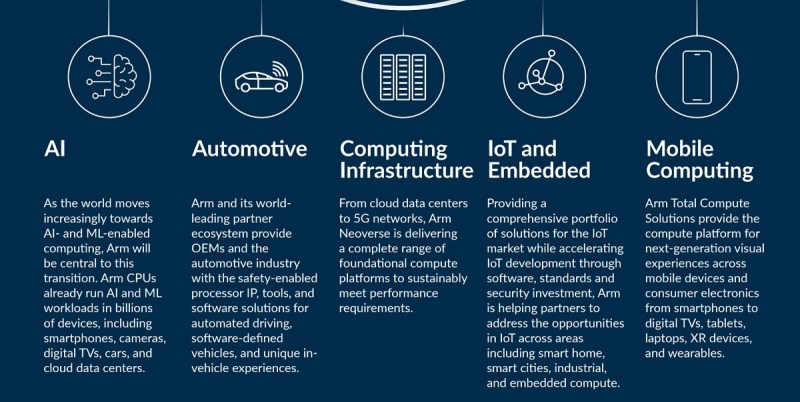Arm to raise $4.7B in IPO that values chip designer at $54.5 billion
5 min read
We’re thrilled to announce the return of GamesBeat Next, hosted in San Francisco this October, where we will explore the theme of “Playing the Edge.” Apply to speak here and learn more about sponsorship opportunities here. At the event, we will also announce 25 top game startups as the 2024 Game Changers. Apply or nominate today!
Arm Holdings, the chip architecture firm owned by SoftBank Group, is poised to raise about $4.7 billion in its initial public offering that valued the company at more than $54.5 billion.
Reuters reported earlier that the IPO was oversubscribed by six times. As such, the company is in a position to break the ice in the IPO market, with hopes that a rally could open the window for other companies to do the same. Yet Masayoshi Son, CEO of SoftBank, reportedly decided the $51 a share price for the 95.5 million shares going up for sale on Thursday was prudent.
SoftBank itself had hoped for a higher valuation, as last month SoftBank acquired the 25% share of Arm that it did not own in the company at a $64 billion valuation.
Cambridge, United Kingdom-based Arm chose to go public in the U.S., creating demand for the largest IPO in U.S. in the past two years. The company has a 99% market share in mobile phones, and it has made incursions into markets such as processors for PCs and servers. Arm’s devices are always energy efficient, as the company’s architecture is a descendant of RISC computing, which focused on energy efficiency while Intel’s rival architecture focused more on performance.
Event
VB Transform 2023 On-Demand
Did you miss a session from VB Transform 2023? Register to access the on-demand library for all of our featured sessions.
But the weak global market has hurt sales. Overall sales totaled $2.68 billion in the 12 months ending March 31, compared to $2.7 billion in the year earlier period. Arm has tried to compensate by moving aggressively into the automotive chip market and other areas as well.
The importance of semiconductor chips

Chips are the foundation of the modern electronics industry. They’re the thumbnail-sized slivers of silicon that, when processed, have billions of components known as transistors on their surfaces. They’re laid out in circuitry that would be more complex than a street map of the globe. A typical semiconductor processor these days has more transistors than 16 times the number of people on Earth.
Back in 1971, Intel’s first microprocessor had 2,300 transistors. Today, the latest Arm-based Apple Watch has 5.9 billion transistors. The reason is the compounding effect of Moore’s Law, the prediction made in 1965 by Intel’s former CEO Gordon Moore, that held that the number of transistors on a chip would double every couple of years.
With such improvements in efficiency, our electronic goods have gotten better every couple of years. They become faster, cheaper smaller, enabling smaller and smaller electronic devices. Moore’s Law has slowed down lately, but the advances are still coming fast. Apple’s latest M2 Ultra processor for its Macs has 134 billion transistors.
The industry hit $574 billion in 2022, a year when the shortage of such chips crippled many industries that were whipsawed by the demand changes during the pandemic. A shortage of chips in 2022 idled Ford’s factories for many weeks of the year, as there weren’t enough chips to put in the finished cars. It’s also why game consoles were in such short supply years into the cycle of the Xbox Series X/S and PlaySTation 5. Shortages like this did untold damage to the world economy.
Chips were such a strategic industry that Congress approved the CHIPS and Science Act in 2022, authorizing $280 billion in new funding to boost domestic research and manufacturing of semiconductor chips in the United States. And Arm is one of the companies that designs the framework — dubbed architecture — for processors that are the brains of the electronic equipment.
Competition

Intel and Advanced Micro Devices are rivals with a focus on x86 architecture, most commonly used in PCs, servers and game consoles.
MIPS is also a rival, and Arm also faces competition from an upstart technology, RISC-V, that is being offered as an open-source alternative with no royalties. It was created by a group of academics who were mortified at the fees that Arm was charging even for research purposes.
Jack Kang, senior vice president at RISC-V chip design firm SiFive, congratulated the rival Arm for its IPO, which he said “represents a momentous step forward for the entire semiconductor ecosystem.”
He said in a statement, “This IPO has brought more awareness to the public about the critical role of computing architectures, specifically the instruction set architecture (ISA), and the need for high-quality, high-performance processor IP to drive our industry forward.”
Kang noted competition is essential for a healthy semiconductor industry, and part of the excitement has been a new recognition of how big the market opportunities are.
“And there is room for all of us. These markets need rapid innovation and customization, which are consistent themes in our conversations with customers. It’s no secret that SiFive’s founders developed RISC-V as a response to the limited customization options of closed, proprietary architectures,” Kang said.
Arm by the numbers

Arm has 5,963 employees from more than 85 countries. About 80% of them on focused on research, design and technical innovation. The company’s engineers invested 10 million hours creating the base software and tools for chips with Armv8 processors. And Arm spent 30 million hours creating the base software and tools for Armv9 processors.
Arm said that in 2023, the total addressable market for its chips is $200 billion in chip value, and that could grow to $250 billion by 2025.
Besides smartphones, Arm is chasing after AI, automotive, computer infrastructure, the internet of things, and chips embedded in appliances and other devices.
Arm said it has more than 1,000 ecosystem partners, meaning the licensees and other supporters who make chips based on Arm’s architectural designs. It’s like Arm designs the framework for a car, and then the chip design and manufacturing firms create individual car models based on the overall structure of having an engine and four wheels.
But Arm also needs to pay attention to geopolitical issues. The U.S. and China have a frosty relationship, and both sides are racing to secure chip supply chains. China accounted for 24.5% of Arm’s revenue in the last fiscal year.
Japan-based SoftBank will still own more than 90% of Arm in the wake of the IPO. Nvidia tried to buy Arm for at least $40 billion, but regulators put a stop to that deal. To shore up its shareholder support, Arm enlisted many clients as cornerstone investors in its IPO, including Apple, Nvidia, Alphabet, Advanced Micro Devices, Intel and Samsung Electronics.
GamesBeat’s creed when covering the game industry is “where passion meets business.” What does this mean? We want to tell you how the news matters to you — not just as a decision-maker at a game studio, but also as a fan of games. Whether you read our articles, listen to our podcasts, or watch our videos, GamesBeat will help you learn about the industry and enjoy engaging with it. Discover our Briefings.


